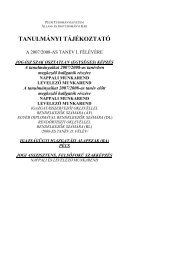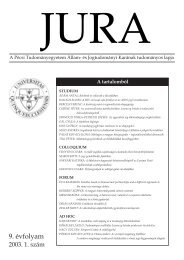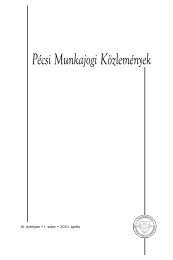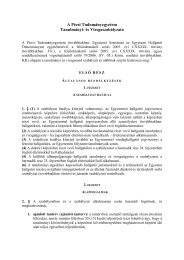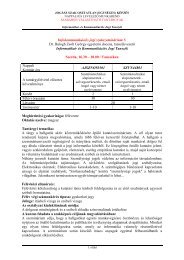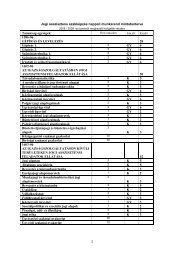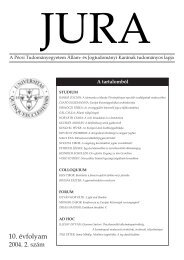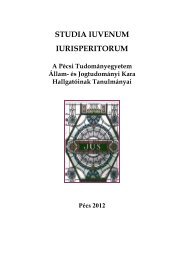2012. évi 2. szám - Jura - Pécsi Tudományegyetem
2012. évi 2. szám - Jura - Pécsi Tudományegyetem
2012. évi 2. szám - Jura - Pécsi Tudományegyetem
- TAGS
- jura
You also want an ePaper? Increase the reach of your titles
YUMPU automatically turns print PDFs into web optimized ePapers that Google loves.
Andityas Soares de Moura Costa Matos: An alternative approach to the basic norm …145Honoré’s second criticism is based on the findingthat there is no reason to consider as valid thechain of authorizations and power delegations thatconnects the founders of a particular legal order tothe current law-makers. In order to justify this idea,Honoré believes that it is necessary to assume asundisputable the transmission of power throughhistorical competence chains, which is nonsensical tohim (Honoré 2007, 103). Although such a transmissionwould be morally questionable, it apparentlymatches the reality, which has no obligation of beingethical. People meet prescriptive provisions made bycompetent authorities because they presuppose validprior authorizations. When one cannot assume suchauthorizations, it means that one is facing a revolution(a hypothesis specifically addressed by Kelsen).Revolutions occur because certain legal order vanishes,giving place to a new order with a new basicnorm. In a few words, the transfer of power ownershipis always presupposed to be valid, unless whenthe overall effectiveness ceases to exist before a newset of norms. This, like the former, also presupposesanother basic norm validating new political-juridicalpower transmissions.3.3 Scientific postulateThe basic norm can be characterized as an rule ofclosure, 11 whose aim is to prevent the endless recurrenceof questions about the basis of the validity ofa law. Therefore, it resembles the scientific systemspostulates that can not be deduced, but from whichothers can be deduced (Bobbio 1999, 62). This seemsto be the best definition of the basic norm’s nature.Indeed, that is referred by Raz when discussing aboutthe two axioms of Kelsen’s theory, which does notneed to be proven (Raz 2007, 48) because of their selfevidentnature, just like scientific postulates. Theyboth concern the basic norm and determine that: 1)given two legal norms, if one authorizes, directly orindirectly, the other, they both must necessarily belongto the same legal system; 12 2) all the legal normsof a particular legal system are authorized, directlyor indirectly, by one single basic norm.Although this interpretation isn’t explicit inKelsen’s works, it can be sustained based on someindirect evidences. In 1923, he commended AlfredVerdross’s doctrine, who understood that the basicnorm is a kind of logical Constitution, which can beseen as – similarly to what occurs with the hypothesisof natural sciences –, an hypothesis concerning thelegal-positive material (Kelsen 2007a, 13). On anotheroccasion, Kelsen explained that the basic norm isa characterizing element of the initial stage in theprocess of creating a certain legal system: “It is thestarting point of a norm-creating process” (Kelsen1961, 114). Our interpretation is designed to give epistemologicalmeaning – beyond the ontological – tothis important sentence. By understanding the basicnorm as a postulate of the science of law, we are ledto reconsider his course of action. Indeed, the basicnorm should not be conceived as the regressive endof the staggered structure, 13 i.e., the culmination ofthe system of positive law, what would make inevitablethe reference to the world of “is”, according toLosano’s critique. It is, actually, the logical beginningof the system, 14 capable of bringing its elements – thelegal norms – to a single source of non-positive validity,which, unlikely the natural law, is juridical.Therefore, the expression “basic norm” seemsright to us, since it makes easier the understanding ofthe basic norm’s founder role in the legal order, epistemologicallyspeaking. The basic norm is not an end,but a beginning, despite the fact that to understandits nature we have to observe it through a posteriorpoint of view – in the historical sense, not epistemological– than the emergence of generally effectivelegal system founded by it, a paradox which, as wesaw, led Amselek and Niort to highlight the allegedlytautological nature of the Grundnorm. However, wemust once again remind of Cohen, whose influenceled Kelsen to develop the basic rule differently thanan empirical hypothesis capable of being tested (Edel2007, 217). It is rather a condition of the system’srationality, which safeguards the Grundnorm beforethe accusation of being tautological. Indeed, the basicnorm epistemologically founded the positive legalsystem, but it is not part of it as an element – it isnot even positive –, but rather as a condition for thesystem’s cognition.Using a metaphor by Honoré, we are able to holdthat the basic norm is something like the Big-Bang.Similarly to the first validated historical Constitution,the Big-Bang is defined as a singularity assumed bycosmologists. They both – the Big-Bang and the firstConstitution – have existed at a remote time from thepast, making it impossible to submit them to causal(Big-Bang) or normative (basic norm) explanations(Honoré 2007, 101-102). Nevertheless, unlike Honoré,we should extend the metaphor to unveil the truenature of the basic norm as a scientific postulate.While it is possible to say that the Big-Bang is anevent designed to understand how the universeworks, the Grundnorm performs a similar functionfor its particular universe, namely the positive legalorder. So, as you cannot explain the Big-Bang basedon the laws of physics – because they were born withthe Big-Bang –, the basic norm is not subject to theontic and gnoseological parameters that describe thepositive legal order. In fact, the Grundnorm is the onethat creates such parameters. Since the Middle AgeJURA 2012/<strong>2.</strong>



